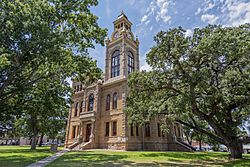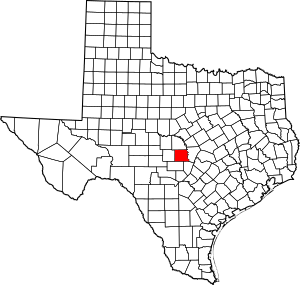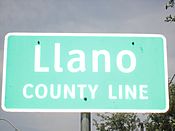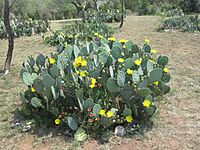Llano County, Texas facts for kids
Quick facts for kids
Llano County
|
|
|---|---|

The Llano County Courthouse in Llano
|
|

Location within the U.S. state of Texas
|
|
 Texas's location within the U.S. |
|
| Country | |
| State | |
| Founded | 1856 |
| Named for | Llano River |
| Seat | Llano |
| Largest city | Horseshoe Bay |
| Area | |
| • Total | 966 sq mi (2,500 km2) |
| • Land | 934 sq mi (2,420 km2) |
| • Water | 32 sq mi (80 km2) 3.3% |
| Population
(2020)
|
|
| • Total | 21,243 |
| • Density | 21.991/sq mi (8.491/km2) |
| Time zone | UTC−6 (Central) |
| • Summer (DST) | UTC−5 (CDT) |
| Congressional district | 11th |
Llano County (/ˈlænoʊ/) is a county located on the Edwards Plateau in the U.S. state of Texas. As of the 2020 census, its population was 21,243. Its county seat is Llano, and the county is named for the Llano River.
Contents
History
- The Tonkawa tribe were the first inhabitants.
- 1842 April 20 – Adelsverein Fisher-Miller Land Grant sets aside three million acres (12,000 km2) to settle 600 families and single men of German, Dutch, Swiss, Danish, Swedish, and Norwegian ancestry in Texas.
- 1844 June 26 – Henry Francis Fisher sells interest in land grant to Adelsverein
- 1845 December 20 – Henry Francis Fisher and Burchard Miller sell their rights in the land grant to Adelsverein.
- 1847 Meusebach–Comanche Treaty Bettina commune, last Adelsverein community in Texas, is established by a group of free thinking intellectuals, and named after German liberal Bettina Brentano von Arnim. The community fails within a year due to lack of any governing structure and conflict of authority.
- 1860 Population 1,101 – 21 slaveholders, 54 slaves
- 1862 One hundred Llano County volunteers join Major John George Walker Division of the Confederate States Army.
- 1864 April – A cavalry company is formed in Llano County under Captain Brazeal to defend the area from Indian attacks. It served under Brig. Gen. John David McAdoo until the war's end, when it disbanded in June 1865.
- 1873 August 4 – Packsaddle Mountain becomes the site of the region's last battle with the Indians. The county's farming economy begins to grow after threats of Indian attacks cease.
- 1892 June 7 – Llano branch of Austin and Northwestern Railroad arrives
- 1893 Completion of County Courthouse, designed by Austin architect A O Watson
- 1895 Llano County Jail erected by the Pauly Jail Building and Manufacturing Company of St Louis, MO
- 1900 Frank Teich establishes the Teich Monument Works
- 1901 Llano Women's Literary Society organized – 16 charter members
- 1901 The Victorian style Antlers Hotel, a railroad resort in Kingsland, opened for business.
Darmstadt Society of Forty
Count Castell of the Adelsverein negotiated with the separate Darmstadt Society of Forty to colonize 200 families on the Fisher–Miller Land Grant in Texas. In return, they were to receive $12,000 in money, livestock, and equipment, and provisions for a year. After the first year, the colonies were expected to support themselves. The colonies attempted were Castell, Leiningen, Bettina, Schoenburg and Meerholz in Llano County; Darmstädler Farm in Comal County; and Tusculum in Kendall County. Of these, only Castell survives. The colonies failed after the Adelsverein funding expired, and also due to conflict of structure and authorities. Some members moved to other Adelsverein settlements in Texas. Others moved elsewhere, or returned to Germany.
Library book bans
Llano county libraries were purged of books containing sex education and discussion of racism in 2021 and 2022 by county commissioners. Titles removed include In the Night Kitchen, Caste: The Origins of Our Discontents, and Between the World and Me. Librarian Suzette Baker in Kingsland was fired for her refusal to remove books from the shelves. The library board voted unanimously to close its meetings to the public in 2022. After a lawsuit was filed, a federal judge ruled in March 2023 that at least 12 of the books must be placed back onto shelves. In response, county commissioners considered closing the library in a special meeting. They have appealed the decision by the federal judge.
Geography
According to the U.S. Census Bureau, the county has a total area of 966 square miles (2,500 km2), of which 934 square miles (2,420 km2) are land and 32 square miles (83 km2) (3.3%) are covered by water.
Enchanted Rock, a designated state natural area and popular tourist destination, is located in southern Llano county.
Two significant rivers, the Llano and the Colorado, flow through Llano County. These rivers contribute to Lake Buchanan, Inks Lake, and Lake Lyndon B. Johnson, which are all located partially within the county.
Major highways
Adjacent counties
- San Saba County (north)
- Burnet County (east)
- Blanco County (southeast)
- Gillespie County (south)
- Mason County (west)
Demographics
| Historical population | |||
|---|---|---|---|
| Census | Pop. | %± | |
| 1860 | 1,101 | — | |
| 1870 | 1,379 | 25.2% | |
| 1880 | 4,962 | 259.8% | |
| 1890 | 6,772 | 36.5% | |
| 1900 | 7,301 | 7.8% | |
| 1910 | 6,520 | −10.7% | |
| 1920 | 5,360 | −17.8% | |
| 1930 | 5,538 | 3.3% | |
| 1940 | 5,996 | 8.3% | |
| 1950 | 5,377 | −10.3% | |
| 1960 | 5,240 | −2.5% | |
| 1970 | 6,979 | 33.2% | |
| 1980 | 10,144 | 45.4% | |
| 1990 | 11,631 | 14.7% | |
| 2000 | 17,044 | 46.5% | |
| 2010 | 19,301 | 13.2% | |
| 2020 | 21,243 | 10.1% | |
| U.S. Decennial Census 1850–2010 2010 2020 |
|||
| Race / Ethnicity (NH = Non-Hispanic) | Pop 2000 | Pop 2010 | Pop 2020 | % 2000 | % 2010 | % 2020 |
|---|---|---|---|---|---|---|
| White alone (NH) | 15,869 | 17,303 | 17,530 | 93.11% | 89.65% | 82.52% |
| Black or African American alone (NH) | 51 | 102 | 97 | 0.30% | 0.53% | 0.46% |
| Native American or Alaska Native alone (NH) | 58 | 87 | 115 | 0.34% | 0.45% | 0.54% |
| Asian alone (NH) | 59 | 76 | 121 | 0.35% | 0.39% | 0.57% |
| Pacific Islander alone (NH) | 5 | 5 | 4 | 0.03% | 0.03% | 0.02% |
| Other Race alone (NH) | 8 | 11 | 61 | 0.05% | 0.06% | 0.29% |
| Mixed Race or Multiracial (NH) | 119 | 175 | 807 | 0.70% | 0.91% | 3.80% |
| Hispanic or Latino (any race) | 875 | 1,542 | 2,508 | 5.13% | 7.99% | 11.81% |
| Total | 17,044 | 19,301 | 21,243 | 100.00% | 100.00% | 100.00% |
As of the 2000 census, 17,044 people, 7,879 households, and 5,365 families resided in the county. The population density was 18 people per square mile (6.9 people/km2). There were 11,829 housing units at an average density of 13 units per square mile (5.0/km2). The racial makeup of the county was 96.3% White, 0.3% Black or African American, 0.4% Native American, 0.4% Asian, <0.1% Pacific Islander, 1.8% from other races, and 0.8% from two or more races. About 5.1% of the population were Hispanics or Latinos of any race.
Of the 7,879 households, 16.9% had children under the age of 18 living with them, 59.5% were married couples living together, 5.0% had a female householder with no husband present, and 31.9% were not families. About 28.3% of all households were made up of individuals, and 16.0% had someone living alone who was 65 years of age or older. The average household size was 2.13 and the average family size was 2.56.
In the county, the population was distributed as 15.9% under the age of 18, 4.5% from 18 to 24, 18.4% from 25 to 44, 30.5% from 45 to 64, and 30.7% who were 65 years of age or older. The median age was 53 years. For every 100 females, there were 94.4 males. For every 100 females age 18 and over, there were 91.7 males.
The median income for a household in the county was $34,830, and for a family was $40,597. Males had a median income of $30,839 versus $21,126 for females. The per capita income for the county was $23,547. About 7.2% of families and 10.3% of the population were below the poverty line, including 17.2% of those under age 18 and 6.0% of those age 65 or over.
Communities
Cities
- Horseshoe Bay (partly in Burnet County)
- Llano (county seat)
- Sunrise Beach Village
Census-designated places
Other unincorporated communities
Ghost towns
Notable person
- Emil Kriewitz, who lived with the Penateka Comanche, served as guide for Fisher–Miller Land Grant settlers, 1870 Llano County justice of the peace, 1871 Llano County election judge, and was postmaster of Castell from 1876 to 1883. He was buried in Llano County Cemetery.
See also
 In Spanish: Condado de Llano para niños
In Spanish: Condado de Llano para niños



